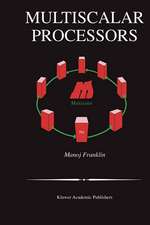Conductor: Distributed Adaptation for Heterogeneous Networks: The Springer International Series in Engineering and Computer Science, cartea 688
Autor Mark D. Yarvis, Peter Reiher, Gerald J. Popeken Limba Engleză Hardback – 31 mai 2002
Conductor: Distributed Adaptation for Heterogeneous Networks describes a new approach to graceful degradation in the face of network heterogeneity - distributed adaptation - in which adaptive code is deployed at multiple points within a network. The feasibility of this approach is demonstrated by conductor, a middleware framework that enables distributed adaptation of connection-oriented, application-level protocols. By adapting protocols, conductor provides application-transparent adaptation, supporting both existing applications and applications designed with adaptation in mind.
Conductor: Distributed Adaptation for Heterogeneous Networks introduces new techniques that enable distributed adaptation, making it automatic, reliable, and secure. In particular, we introduce the notion of semantic segmentation, which maintains exactly-once delivery of the semantic elements of a data stream while allowing the stream to be arbitrarily adapted in transit. We also introduce a secure architecture for automatic adaptor selection, protecting user data from unauthorized adaptation. These techniques are described both in the context of conductor and in the broader context of distributed systems. Finally, this book presents empirical evidence from several case studies indicating that distributed adaptation can allow applications to degrade gracefully in heterogeneous networks, providing a higher quality of service to users than other adaptive techniques. Further, experimental results indicate that the proposed techniques can be employed without excessive cost. Thus, distributed adaptation is both practical and beneficial.
Conductor: Distributed Adaptation for Heterogeneous Networks is designed to meet the needs of a professional audience composed of researchers and practitioners in industry and graduate-level students in computer science.
| Toate formatele și edițiile | Preț | Express |
|---|---|---|
| Paperback (1) | 643.50 lei 43-57 zile | |
| Springer Us – 30 oct 2012 | 643.50 lei 43-57 zile | |
| Hardback (1) | 649.93 lei 43-57 zile | |
| Springer Us – 31 mai 2002 | 649.93 lei 43-57 zile |
Din seria The Springer International Series in Engineering and Computer Science
- 24%
 Preț: 1041.97 lei
Preț: 1041.97 lei - 20%
 Preț: 643.50 lei
Preț: 643.50 lei - 18%
 Preț: 1225.62 lei
Preț: 1225.62 lei - 18%
 Preț: 965.02 lei
Preț: 965.02 lei - 20%
 Preț: 646.12 lei
Preț: 646.12 lei - 18%
 Preț: 948.79 lei
Preț: 948.79 lei - 20%
 Preț: 646.62 lei
Preț: 646.62 lei - 15%
 Preț: 637.46 lei
Preț: 637.46 lei - 20%
 Preț: 643.83 lei
Preț: 643.83 lei - 18%
 Preț: 949.23 lei
Preț: 949.23 lei - 20%
 Preț: 644.48 lei
Preț: 644.48 lei - 20%
 Preț: 994.92 lei
Preț: 994.92 lei - 20%
 Preț: 645.97 lei
Preț: 645.97 lei - 18%
 Preț: 946.87 lei
Preț: 946.87 lei - 20%
 Preț: 995.57 lei
Preț: 995.57 lei - 18%
 Preț: 956.99 lei
Preț: 956.99 lei - 20%
 Preț: 644.98 lei
Preț: 644.98 lei - 15%
 Preț: 649.54 lei
Preț: 649.54 lei - 18%
 Preț: 950.21 lei
Preț: 950.21 lei - 18%
 Preț: 1221.38 lei
Preț: 1221.38 lei - 18%
 Preț: 957.62 lei
Preț: 957.62 lei - 15%
 Preț: 643.99 lei
Preț: 643.99 lei - 18%
 Preț: 948.47 lei
Preț: 948.47 lei - 18%
 Preț: 947.35 lei
Preț: 947.35 lei - 20%
 Preț: 1284.65 lei
Preț: 1284.65 lei - 20%
 Preț: 1633.95 lei
Preț: 1633.95 lei - 20%
 Preț: 1285.78 lei
Preț: 1285.78 lei
Preț: 649.93 lei
Preț vechi: 812.42 lei
-20% Nou
Puncte Express: 975
Preț estimativ în valută:
124.37€ • 130.17$ • 103.51£
124.37€ • 130.17$ • 103.51£
Carte tipărită la comandă
Livrare economică 31 martie-14 aprilie
Preluare comenzi: 021 569.72.76
Specificații
ISBN-13: 9781402070877
ISBN-10: 140207087X
Pagini: 232
Ilustrații: XIX, 232 p.
Dimensiuni: 155 x 235 x 16 mm
Greutate: 0.54 kg
Ediția:2002
Editura: Springer Us
Colecția Springer
Seria The Springer International Series in Engineering and Computer Science
Locul publicării:New York, NY, United States
ISBN-10: 140207087X
Pagini: 232
Ilustrații: XIX, 232 p.
Dimensiuni: 155 x 235 x 16 mm
Greutate: 0.54 kg
Ediția:2002
Editura: Springer Us
Colecția Springer
Seria The Springer International Series in Engineering and Computer Science
Locul publicării:New York, NY, United States
Public țintă
ResearchCuprins
1. Introduction.- 1.1 Distributed Adaptation.- 1.2 Assumptions.- 1.3 Terminology.- 1.4 Key Contributions of this Research.- 1.5 Roadmap.- 2. Conductor: A New Approach.- 2.1 The Conductor Approach.- 2.2 The Conductor Architecture.- 2.3 Key Challenges.- 2.4 Potential Pitfalls of Distributed Adaptation.- 2.5 Conclusions.- 3. Stream Interception and Identification.- 3.1 Interception in Conductor.- 3.2 Type Identification.- 3.3 An Example of Interception and Identification.- 3.4 Conclusions.- 4. Selecting and Deploying Distributed Adaptations.- 4.1 Properties of a Good Solution.- 4.2 Criteria for Adaptor Selection.- 4.3 Approaches to Distributed Adaptor Selection.- 4.4 Conductor’s Planning Architecture.- 4.5 Plan Formulation.- 4.6 The Cost of Automatic Planning.- 4.7 Conclusions.- 5. Securing Distributed Adaptation.- 5.1 Design of Conductor Security.- 5.2 Authentication Schemes.- 5.3 Attacks and Countermeasures.- 5.4 Multiple Security Schemes.- 5.5 Non-Enabled Client and Server.- 5.6 Applicability to Other Open Architectures.- 5.7 Implementation.- 5.8 Conclusions.- 6. Reliability for Distributed Adaptation.- 6.1 A New Model of Reliability.- 6.2 Semantic Segmentation.- 6.3 Preventing Data Loss Despite Adaptation.- 6.4 Protecting Adaptation from Failures.- 6.5 Handling Multiple Failures.- 6.6 Semantic Segmentation for Other Transport Protocols.- 6.7 Round-Trip Reliability.- 6.8 Conclusions.- 7. Adaptor Construction.- 7.1 Writing Conductor Adaptors.- 7.2 Sample Adaptations.- 7.3 Challenges in Adaptor Construction.- 7.4 Conclusions.- 8. External Interfaces.- 8.1 Control of Application-Transparent Adaptation.- 8.2 An API for Adaptation-Aware Applications.- 8.3 External Control of Adaptation-Aware Applications.- 8.4 Conclusions.- 9. Experiences with Conductor.- 9.1 ExperimentalSetup.- 9.2 Effectiveness of Conductor.- 9.3 Data Handling Overheads.- 9.4 The Cost of Automatic Planning.- 9.5 The Cost of Semantic Segmentation.- 9.6 The Cost of Failures.- 9.7 The Cost of Security.- 9.8 Initial Deployment.- 9.9 Conclusions.- 10. Related Work.- 10.1 Adaptation.- 10.2 Reliability.- 10.3 Security.- 10.4 Conclusions.- 11. Future Work.- 12. Conclusions.- 12.1 Summary of the Problem.- 12.2 The Conductor Solution.- 12.3 Research Contributions.- 12.4 Broad Lessons.- 12.5 Final Comments.- A. Data Tables.- Trademarks.- References.





















